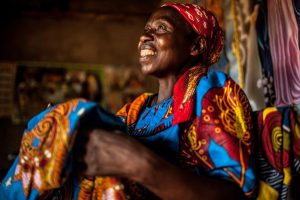Civil war broke out in Rwanda in 1990, exacerbating existing tensions between the Tutsi minority and Hutu majority. The civil war began when Rwandan exiles formed a group called the Rwandan Patriotic Front (RPF) and launched an offensive against Rwanda from their home base in Uganda.

“When I couldn’t afford school fees the children could not go to school, they had to stay at home. I had no peace of mind.
“What makes me proud is collaborating with my husband. In my opinion, happiness means feeling comfortable at home, getting advice from your husband and vice versa, understanding each other, and fairly enjoying your income.”
The RPF, which was comprised of mostly Tutsis, placed blame on the government for failing to address the Tutsi refugees. All Tutsis in the country were characterized as accomplices of the RPF and all Hutu members of the opposition parties were deemed traitors. Despite the opposition forces reaching a peace agreement in 1992, political negotiations continued in attempts to achieve harmony between the Tutsis and Hutus.
On April 6th 1994, as Rwandan President Juvenal Habyarimana returned from a round of talks in neighboring Tanzania, he was killed when his plane was shot down outside of the country’s capital, Kigali.
Following the crash, the U.S. Deputy Assistance Secretary of State warned of “the strong likelihood that widespread violence could break out.”
The president’s death provided a spark for an organized campaign of violence against Tutsi and moderate Hutu civilians across the country. In just a matter of hours, Hutu rebels surrounded the capital and took over the streets of Kigali. Within a day, the Hutus had successfully eliminated Rwanda’s moderate leadership. As the weeks progressed, Tutsis and anyone suspected of having any ties to a Tutsi, were killed.
The political vacuum enabled Hutu extremists to take control of the country. Detailed lists of Tutsi targets were prepared in advance and government radio stations called upon Rwandans to murder their neighbors. These specific lists included names, addresses and sometimes license plates. Through radio hate speech, people were encouraged to take the streets and exterminate those who matched the list.
The Power of the Radio

Sophie Turner in Rwanda.
The radio was utilized to not only list the location of specific Tutsis to be targeted, but to also justify the genocide. Radio hosts discussed discrimination the Hutus suffered under the power of the Tutsis.
Strong connotations describing Hutus as slaves during colonization painted the Rwandan genocide as a type of slave rebellion. Radio stories were used to anger the Hutus and channel that anger into action. Radio was also used to dehumanize Tutsis by calling them “cockroaches,” making acts of violence against them seem less inhumane.
The extremist Hutus strategy turned into an extermination campaign as they began to encounter resistance from the Rwandan Patriotic Front (RPF), a Tutsi rebel group. The RPF fought back as the violence grew more severe, creating a toxic mix of both civil war and genocide. In response, the Hutus changed their strategy, believing if the opposition was completely exterminated, their majority power and status would be reassured and preserved. Thus, they set out to get rid of the Tutsis completely.
In addition to the brutal mass killings, systematic rape was also widely used as a weapon of war during the Rwandan genocide. The exact number is unknown, but it is estimated that between 250,000 and 500,000 women were raped. It was considered another way to destroy the Tutsi ethnic group, through both the emotional pain (so the woman could “die of sadness”), and through the health problems that would be a result. Often times, women did not even have to succumb to the aftermath of rape as they were often immediately killed right after.
Over the course of the 100 days, the RPF began to make gains on both the battlefield and in the negotiations led by Tanzania. By early July, the RPF had control of the majority of the country. Fearing reprisal killings, hundreds of thousands of Hutus fled the country.

